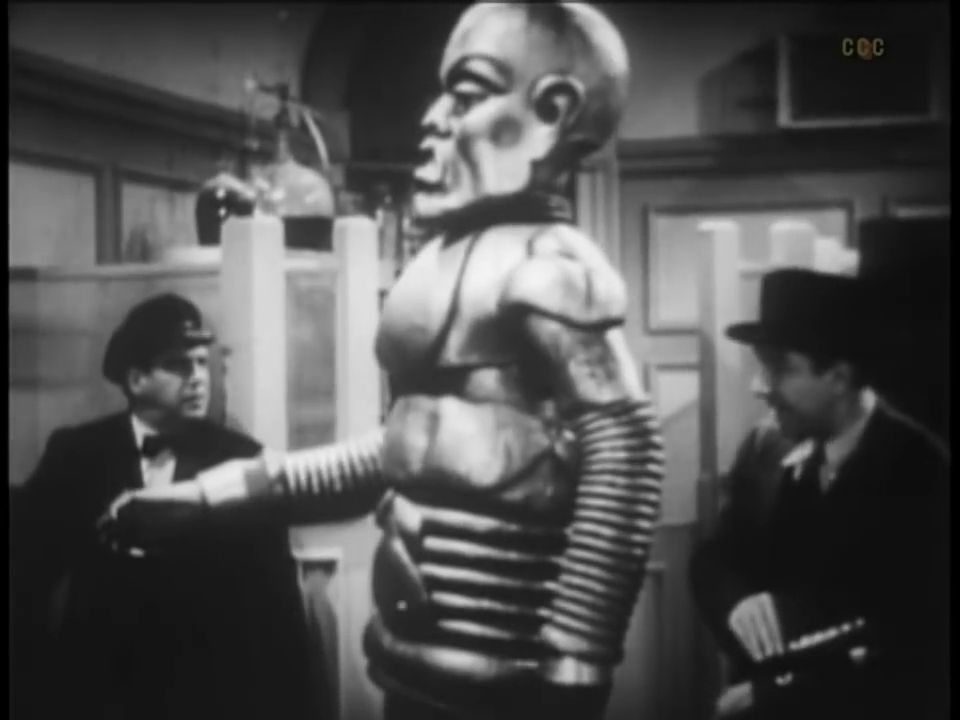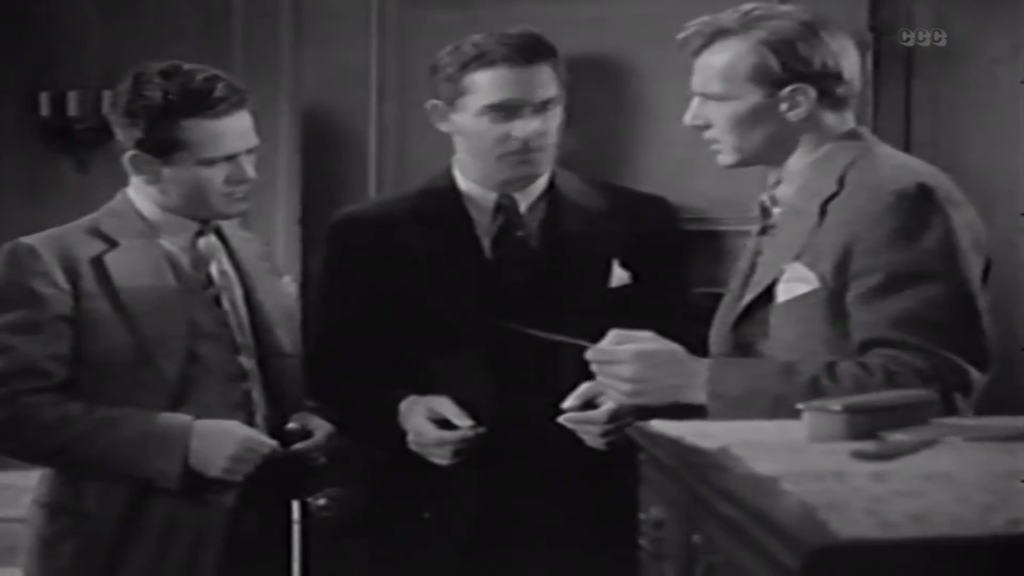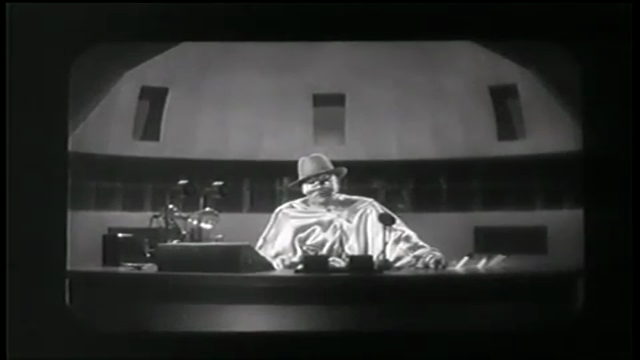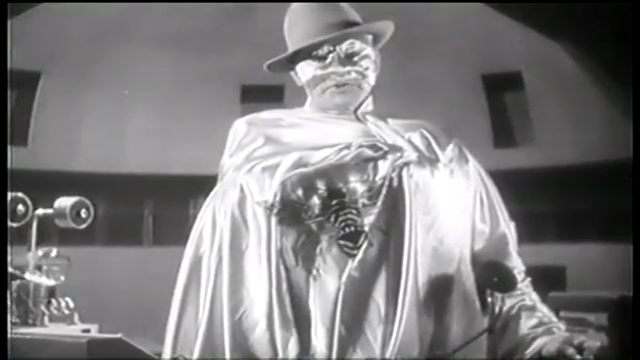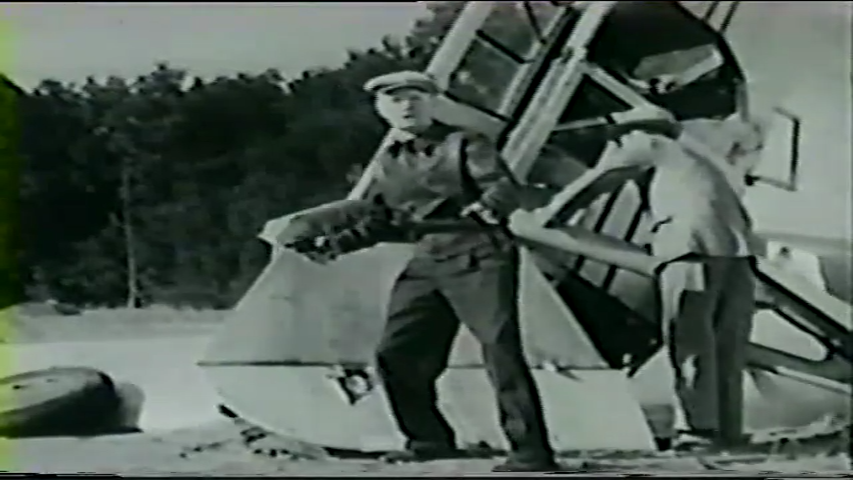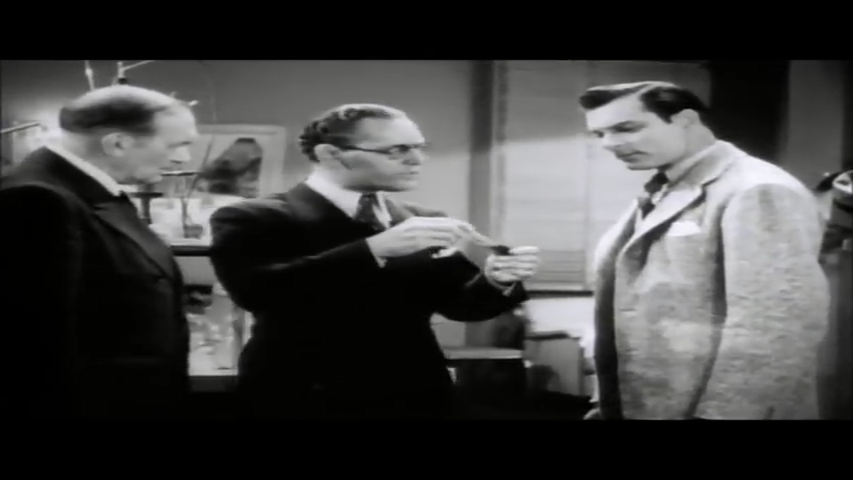-
#456 – The Phantom Creeps (1939)
The Phantom Creeps (1939)
Film review #456
Directors: Ford Beebe, Saul A. Goodkind
SYNOPSIS: An evil scientist named Dr. Zarko has developed inventions that he intends to use to take over the world. With the government and foreign spies constantly trying to get him to get a hold of his inventions, Zarko is uninterested until his wife his killed, when Zarko swears vengeance against the world. Faking his own death, he adopts a new disguise and sets to work. Bob West, a government agent, works together with Dr. Frank Mallory, Zarko’s once-assistant, and journalist Jean Drew to try to foil Zarko’s various attacks and the spies who want his work, while beginning to suspect Zarko is not dead after all…
THOUGHTS/ANALYSIS: The Phantom Creep is a 1939 film serial composed of twelve chapters. Most notable for featuring film icon Bela Lugosi as the villain, it would also be the last movie serial he would star in. The serial starts off introducing Lugosi’s character Dr. Alex Zarko, a brilliant scientist but a bit eccentric as he likes to play tricks on the government agents and foreign spies that are attempting to buy or steal his inventions. He takes everything in good stride until his wife is killed, and the thought of vengeance on the world completely consumes him, and begins using his inventions for evil after faking his own death. Government agent Bob West teams up with Dr. Frank Mallory, who was Zarko’s assistant who wanted him to donate his inventions to the government for the benefit of mankind, and left when he refused. Also working with Jean Drew, a journalist at a national newspaper. Together, they take on the spies that are attempting to get a hold of Zarko’s inventions, and investigate whether Zarko is really dead. One thing that stands out in this serial is all the various inventions that Zarko uses. He has invisibility, an eight-foot robot, robotic spiders that can paralyze people and also a device to put people into suspended animation. Normally, only one of these inventions would serve as the main plot point for a serial, but this serial gives us all of them. While all of these inventions have been the focus of other serials, having them all together like this gives some much needed variety, as different chapters focus on different things, and are used fairly creatively in the various schemes and set-ups. The plot has a lot of back-and-forth with the characters ending up at Zarko’s old home many times, only to be continually come under attack and being surprised when they do so. The story goes round in circles and lacks some direction with so many different things happening, but it’s better than nothing happening, which is what many serials do when they try to stretch very little over twelve to fifteen chapters.
In terms of characters, they are nothing special: there’s all the usual characters from the young action-hero, the sole female etc., but the star of the serial is obviously Bela Lugosi, who gets first billing, and is always the star of every film he is in. His performance is similar to his usual roles (he is the villain in a few serials), but he undoubtedly draws in the audience for those very roles. He also has an assistant called Monk, who plays the role of the idiotic assistant who bungles and sometimes intentionally sabotages Zorka’s plans provides some comedic value, but is mostly there to give Zorka someone to interact with and get his wrath out on.
With all of the inventions and devices that form the backbone of the action, the effects are fairly well pulled off. Of course, the mechanical spiders and the floating objects being carried by an invisible Zorka aren’t convincing nowadays, but there’s definitely worse I’ve seen in the serials of this time. One thing of interest is that there’s not many fistfights or gun shoot-outs, which is usually what most of the action in serials consist of. This serial has all of the inventions to replace that, but also focuses a little more on setting up large scale explosions or vehicle crashes that form the chapter’s cliffhangers. The chapters are also fairly longer than usual, going to about twenty minutes whereas some serials only have fifteen minute chapters with a lot of reused footage from a previous chapter. As such, I think you would get your value for money going to watch this at the theatre in comparison to others. Overall, The Phantom Creeps has a fair amount to offer viewers with its imaginative inventions, and Lugosi’s star quality. The story lacks direction sometimes and the other characters fall flat due to some dull acting and lack of anything unique about them, but overall the serial has enough to make it an above average venture.
-
#442 – Daredevils of the Red Circle
Daredevils of the Red Circle (1939)
Film review #442
Directors: William Witney, John English
SYNOPSIS: Three daredevils are performing their regular circus act when sabotage leads to a huge fire breaking out, and the death of the young brother of one of the performers leads to them wanting to seek revenge. They learn that a former prisoner is responsible, and is attempting to destroy the properties of Granville, the man which put him away. The daredevils team up with Granville, but little do they know that the Granville they are working with is actually prisoner “39013″, who has assumed Granville’s identity and kept the real one locked up in his basement as a means to exact his revenge. The daredevils must work together to stop 39013 and unravel the mystery, aided by a mysterious ally known as the “Red circle,” who communicates with them only through notes in order to alert them of 39013′s plans and to keep their identity a secret…
THOUGHTS/ANALYSIS: Daredevils of the Red Circle is a 1939 serial film comprised of twelve chapters. The serial opens up with the daredevils Gene, Tiny and Burt performing their show at a circus owned by millionaire philanthropist Horace Granville. Meanwhile, ex-prisoner and former business partner of Granville Harry Crowel, who now goes by his prisoner number “39013″ (pronounced thirty-nine oh thirteen), plans to get revenge on Granville, who put him in prison. 39013 sabotages the next show of the daredevils, causing the circus to go up in flames and killing Gene’s kid brother. They decide to get revenge by teaming up with Granville to stop 39013, but little do they know the Granville they are working with is actually 39013 himself, disguising himself as Granville, who is actually locked in the basement, and ruining his life from within. The rest of the serial comprises of the Daredevil’s attempts to foil 39013′s various schemes, while being aided by notes left for them by the mysterious “Red Circle.” The story and format are all very familiar to serial goers, with the opening chapter actually showing off the unique aspects of the characters doing their daredevil tricks and stunts, and then in subsequent chapters hardly ever being seen again, with the aim of the expensively produced first chapter being used to draw viewers in and convince them to come back to the theatre week after week to watch subsequent ones. The death of Gene’s young brother Sammy is an unusually dark premise to open on, as the kid character is a staple of many serials that younger viewers may relate to, rather than them being killed off in the first ten minutes. The rest of the serial is a very familiar story though, with each chapter introducing a new plot to destroy another of Granville’s industries or properties, and the daredevil’s attempting to stop the. There’s some decent variety and action sequences, but nothing too memorable amongst the huge amount of times they have been done across the format.
The characters are the usual suspects in this serial, with the three daredevils being the usual young, athletic, ideal Americans who can pull off all the necessary stunts and fistfights that the story demands. They are all defined as having a speciality in particular aspects of daredevilry, but we never see those particular talents define their character beyond the first chapter, and they all feel very similar to one another. Blanche as the granddaughter of Granville plays the typical token female character and as usual has very little to do for the majority of the serial. 39013 is a fairly typical villain, but at least he has a clear motive and purpose. He is played by Charles Middleton, who most famously was the villain Ming the Merciless in the Flash Gordon serials, and later the villain in the Jack Armstrong serial. The man certainly knows how to play a villain. The rest of the characters don’t leave much of an impression, apart from the dog Tuffie, who is obviously well trained. The one seriously problematic character is that of “Snowflake,” a black man who serves as a “servant” in the Granville household. Like nearly every black person in cinema at this time, they are portrayed as simple-minded and clumsy, alongside being the butt of every joke. Obviously this is an extremely racist and problematic representation that films created and perpetuated during this time, and badly dates the serial.
The serial makes use of some decent settings and set-ups for it’s end-of-chapter cliffhangers, such as chapter two’s flooding tunnel in which one of the daredevils has to escape on a motorbike. The effects aren’t convincing by today’s standards, but are decent for the time. The plot ramps up at the end of the tenth chapter, where 39013 is unmasked and flees while the real Granville is rescued, and this makes a change to everything usually being resolved in the last five minutes in other serials. However, it throws away that excitement by using chapter eleven as a “recap” chapter consisting mostly of clips from the previous chapters, which really stops the excitement in its tracks. Overall, Daredevils of the Red Circle has some decent moments and a fair amount of excitement, but a number of problems make it feel very dated and not really worth returning to.
-
#440 – Mandrake, the Magician (1939)
Mandrake, the Magician (1939)
Film review #440
Directors: Norman Deming, Sam Nelson
SYNOPSIS: The magician Mandrake and his assistant Lothar are performing magic shows on a cruise liner when they make the acquaintance of Professor Houston, who claims to have invented a “Radium energy machine.” When this miraculous invention is stolen by a criminal known only as “The Wasp,” Mandrake must use all of his cunning to recover the machine and defeat the villainous criminal mastermind.
THOUGHTS/ANALYSIS: Mandrake, the Magician is a 1939 movie serial comprised of twelve chapters, and based off the comic strip of the same name. the serial starts out on a cruise ship with Mandrake performing a magic show with his assistant Lothar, when they make the acquaintance of Professor Houston, who has developed a radium energy machine for the good of mankind. When Mandrake visits Professor Houston and his family at his home, he finds that the radium gun has been stolen by a criminal mastermind known only as “The Wasp,” who wants to use it for nefarious purposes. This begins the usual serial plot of attempting to stop the mysterious criminal mastermind and his henchman by foiling their various plots, with car chases, fistfights and explosions along the way. It’s fairly standard stuff for the format, and content I have reviewed plenty of times for the other serials I have reviewed. There’s enough action and variety to be entertaining for the time, but not much to enthral viewers nowadays.
The comic strip character Mandrake was very much a proto-superhero, using illusion, hypnosis and trickery in his masked disguise to thwart villains. This serial adaptation does what most similar adaptations of these characters do, and simply use a recognisable name and strip down anything unique or interesting (or anything too expensive to accomplish) to fit them into the serial format of the All-american hero who solves all his problems with his fists. Mandrake’s “magic is reduced to some cheap novelty tricks which only feature prominently in the first chapter (with the usual purpose of enticing viewers into theatres to watch it and returning for subsequent chapters, despite these subsequent ones lacking the excitement of the first). There’s a scene where the villains tie up Mandrake’s hands, but obviously being a magician, he can easily slip out of them; the villains should probably have thought about that a bit. The rest of the characters are unnoteworthy: Lothar as Mandrake’s assistant is the only non-white person and refers to Mandrake as “Master,” which is a typical portrayal of non-white characters as subservient to the main characters. Professor Houston’s family includes his daughter Betty (as the token female character) and Tommy Houston as the “kid” character the younger viewers can identify with. The Wasp is another serial villain who takes the identity of an animal, and is also secretly one of Mandrake’s allies; a plot point that is only revealed in the last ten minutes or so, and has no real impact on the plot anyway. His disguise is quite distinct, but other than that there’s nothing particularly memorable about him.
As always with these serials, there’s a strict (no) budget to these serials, with nothing too fancy beyond explosions, car chases, and stock footage from anything more extravagant. The sets at least have some effort put into them as well as the radium machine itself looking like an interesting prop. The shots of models being destroyed are, while not convincing by today’s standards, are visually arresting. The cliffhangers employ a variety of situations that put the protagonists in danger, but as always are resolved rather unremarkably. I think Mandrake, the Magician could have been an interesting serial if it would have focused on the “magic” angle a bit more, and offered some different action and heroics to set it apart from other serials. As it is though, it follows the typical formula of using the name of a popular character and taking out all their unique features to fit the pre-established serial format to allow for quick production and release. There’s nothing overly bad about it, but it is unremarkable in the plethora of these stories in the serial format.
-
#438 – Flying G-men (1939)
Flying G-Men (1939)
Film review #438
Directors: Ray Taylor, James W. Horne
SYNOPSIS: Three government ‘G-men’ are tasked with taking down a spy ring that are targeting military defences. To do so, one of them also takes on the masked identity of “The Black Falcon” to operate beyond their operative limits to bring the spies to justice. Learning that a man known only as “The Professor” is leading the spies, they suspect the owner of the local airport to be involved somehow, and work to unravel the mystery and prevent the spies from getting their hands on a new experimental aircraft…
THOUGHTS/ANALYSIS: Flying G-men is a 1939 film serial comprised of fifteen chapters. The seral starts out with four government G-men being assigned to protect a new military aircraft. When one of them is killed by a group of spies attempting to steal the aircraft, the three remaining G-men attempt to hunt down the spy ring before they can sabotage any military defences. To do so, one of them disguises themselves as “The Black Falcon,” who operates individually from them beyond the confines of their job to stop the spy ring. The story is composed of many familiar serial tropes; with the villain secretly being a close associate of the protagonists, plenty of fistfights and chases in cars and planes, and a masked identity for the heroes so they can operate beyond the bounds of the law (this trope saw a decline in the wartime serials, probably because seeing heroes operating beyond the law was a bit too rebellious and similar to spy activities). The identity of “The Black Falcon” as being one of the three heroes and kept secret is a lesser used trope, but has been done before, and their actual identity doesn’t really have any impact on the story. The serial does have a very high-action feel, with it maintaining its energy throughout the chapters, and quickly moving from one action sequence to another. There’s a little bit of standing around and explaining the plot, but it’s nowhere near as bad as some other serials. If you were to go to the theatre each week to watch every new chapter, you would at least get to see plenty of action and be reasonably entertained for fifteen minutes.
The three main characters are the usual heroic leads, in that they are the young, athletic men who can throw the punches in fistfights and jump out of cars without any danger to themselves. being three of them, there’s no need for the usual sidekick character that accompanies the hero to help in the action scenes. There’s nothing to really distinguish the three, apart from one of them being The Black Falcon, the identity of which is revealed in the last minute and has no impact on the plot. However, the three do work together well, and co-ordinate together so you get the sense that they do know each other well. Supporting characters include the sole female character and her young brother, who provides the role that younger viewers can relate with. Their characters are nothing special but do have certain chapters that focus on their actions, so that helps give the serial some variety. The villains are altogether rather uninteresting, with “The Professor” being the mastermind of the spy ring, but his motivations are never explored, making him a rather flat character. His identity as one of the G-men’s friends is not fleshed out, and a very typical plot device of the format.
The car chases and airplane fights, while obviously cheaply produced, work decently enough, and there’s enough explosions and shootouts to keep viewers entertained. There’s also a fair amount of locations used in the serial, as the heroes fight their way though multiple enemy bases. There’s enough variety and action that would have kept the viewers going to the theatre to see Flying G-men to be fairly satisfied, even if it doesn’t do anything too special to set itself apart.
-
#384 – Dick Tracy’s G-Men (1939)
Dick Tracy’s G-Men (1939)
Film review #384
Directors: William Witney, John English
SYNOPSIS: F.B.I. agent Dick Tracy has successfully captured the international spy Zarnoff, who has been sentenced to death. However, he manages to escape, and picks up where he left off attempting to steal or sabotage military equipment to sell to the ‘three powers’, as Dick Tracy once again tries to stop him.
THOUGHTS/ANALYSIS: Dick Tracy’s G-Men is a 1939 film serial and the third Dick Tracy serial. In the opening, we see a film showing how F.B.I. agent Dick Tracy successfully captured foreign spy Zarnoff, who has now been sentenced to death by gas chamber. While in jail awaiting his sentence however, Zarnoff is sent a newspaper which is laced with a substance which when ingested, causes him to appear dead and stop breathing before he is taken to the gas chamber. While his body is being transferred, members of Zarnoff’s gang hijack the ambulance and steal his body, subsequently reviving him since the substance caused him to stop breathing before he went into the gas chamber, therefore did not breathe in any of the lethal gas (yes, it sounds a bit farfetched). When Dick Tracy learns of Zarnoff’s escape, he again attempts to catch up with him, as Zarnoff has sworn revenge against Tracy. The story, split into fifteen chapters, revolves around (as you would expect) Tracy attempting to foil the numerous schemes of Zarnoff, which, as is a staple of the Dick Tracy serials, outperforms others in the genre by having plenty of variety and imagination, splitting the time between investigation and action scenes. It still sticks rigidly to the serial format, and is essentially more of the same, but its predecessors were popular, so there isn’t really much need to drastically change them. The story around the spy Zarnoff attempting to sell American secrets to the “three powers” would have been more relevant to the time it was released, as World War II had essentially begun, so the theme of spies and espionage would have been particularly poignant, with the “three powers” clearly being a reference to the axis powers.
One more significant change in Dick Tracy’s G-Men was the thinning out of the cast. A number of the characters do not return, including Mike McGurk and Junior, who mostly provided the comic relief, and so the film does feel a bit more serious, again with the back drop of a world war looming. In fact, Ralph Byrd, who plays Dick Tracy, is the only returning actor. Even though the characters Steve Lockwood, a fellow F.B.I. agent, and Gwen Andrews, Tracy’s assistant still show up, they are played by different actors. The character Zarnoff is of particular interest, as he looks like a cross between Stalin and some east-Asian influences, which makes sense given the time of release, and America’s animosity to that area of the world (there were many serials produced around the second World war that utilised a villain that was made to look Chinese or east-Asian).
The pacing of the film is fairly standard, with a new scheme showing up every two or three chapters to keep things interesting, and the standard cliffhanger at the end of each chapter to entice viewers to return to the theatre next week to the next chapter. The ending sees Zarnoff and Tracy crash a plane in the desert, with the two handcuffed together, they are desperate to find water when eventually finding some, Zarnoff knocks Tracy out and uncuffs itself. When Lockwood shows up and finds Tracy, they see that the water contains Arsenic, and shortly find Zarnoff’s body (offscreen) as he has died from ingesting the water. Not exactly a thrilling conclusion, but they never are after investing so much time into these serials they never end on much of a high note. Nevertheless, Dick Tracy’s G-Men is more of the same, but it still maintains a position well above most of the format in terms of action, pacing and characters.






